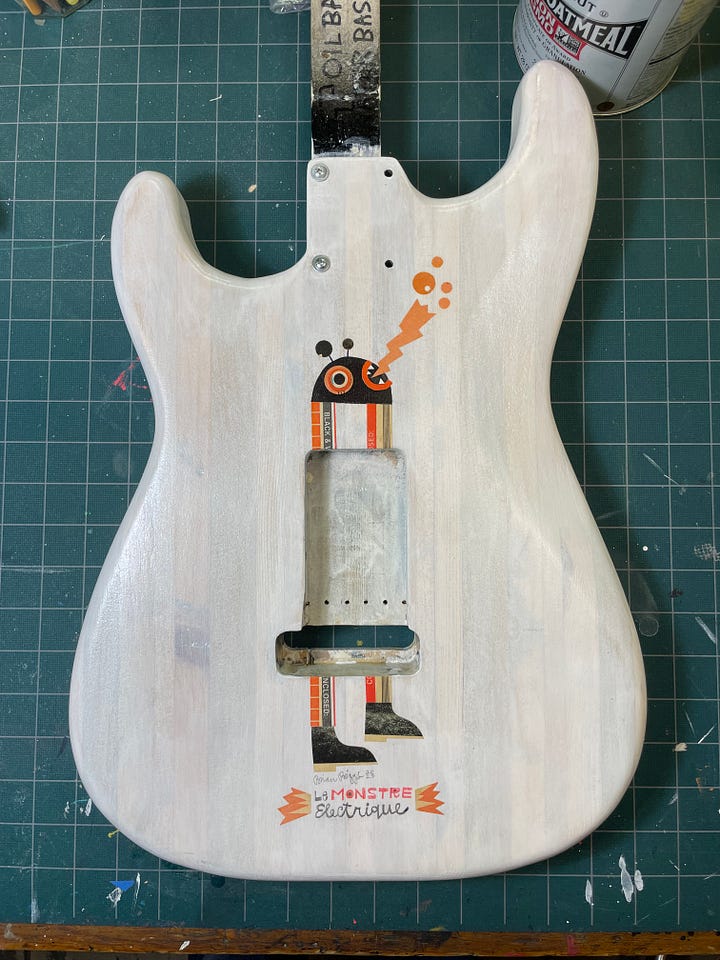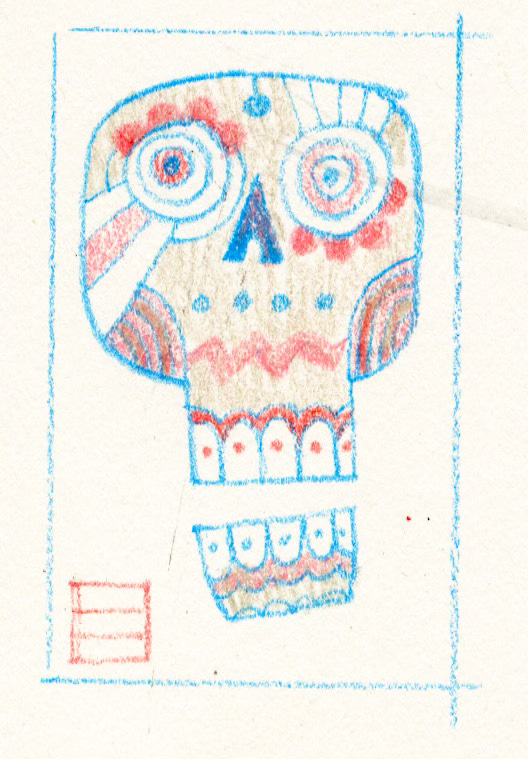I left you last week after mentioning that I somehow went ten years between making my race-car collages, where I fell in love with the medium and the process, and making another collage. Work got in the way, I had a different headspace, I needed to get out of the studio. Whatever. I knew the whole time I’d get back to it. And in late 2019, I did. I took what I knew about the cars and began a series of another really fun subject: TRUCKS!
The idea behind the trucks was that, after illustrating more than 50 children’s books, I’d never made a book without using digital tools. As I wrote last week, what drew me to collage in the first place, in 2009, was the fact that my work was so reliant on Photoshop, and I missed the tactile, and improvisational nature of actually drawing and painting (and cutting and gluing paper). The process of an illustrator making illustrations without a scanner or Photoshop, and then books from those illustrations, seems like a magic trick to me. And I felt like it was somehow important for me to know that I could do this, that I could create something totally here on my desk, with my hands, and it could be published.1
I knew that finding a manuscript that would work with my collages would be impossible. First of all, all I had made was the race cars, and unless the book was about race cars, it wasn’t happening. Second, they looked so very different from anything else I made. Third, and really most important, is that even if the first two reasons weren’t true, I knew that this process would not really lend itself to the kind of work that is necessary for a picture book. The materials were too unique. If I was illustrating a book about a child with curly hair, for example. I’d have to find some collage material to make that curly hair. Fine. But then I’d have to have enough of that printed matter, or whatever it is, to make that curly hair on every page where the child appears. And then also the child’s jacket. And her stockings. And then the background, and other characters. And even if I had the material, making these illustrations would become tedious work, matching these things over 32 pages. The whole reason I make these collages is for the surprise, the accidents2. If I was going to make a book that used collage, it would have to be a subject or a story where each illustration was different. Every “drawing” was something new.
Using the same process, almost exactly, as the race cars, I created four new trucks. While making these trucks, I also began writing a story called “T is for Truck.” This was to be an alphabet book with 26 trucks, each starting with a letter of the alphabet. A is “Animal Truck,” B is “Bookmobile,” C is “Car carrier,” and so on. You can see Rolly’s Robot Repair and Green Garbage Truck below. The Duck truck I made before I thought of this idea, so it doesn’t really correlate.



The manuscript was a rhyming script. Not technically related to collage, but here are two of the rhymes:
Green Frogs and brown toads and several red foxes
Birds on the roof, and insects in boxes
Dozens of rabbits and some other mammals
The driver has humps, I think he’s a camel!
Animal Truck!
Novels and poems and nonfiction histories.
An atlas, an almanac, and whodunit mysteries.
Turn off the TV, it’s long overdue
We’ve got things to read, we’re coming for you.
Bookmobile!
Pretty good, right? I have 24 more of these! But this book never happened. There were two main reasons:
First, ABC books are a tough sell. Who wants to publish a book that will have at least 52 pages, probably more, and will really only be for, like, toddlers?
Second, the collages were made in late 2019, the pitch was prepared in early 2020. Remember what happened in March 2020? Yeah. Me too.
I still want to do something with this idea. If not an alphabet book, then something with trucks, or a duck.3
I really loved making these truck collages. Even more than I did the race cars. I feel like I used the materials better. I added some fun painted parts. I used painted color backgrounds. And, once again, I went years before making another collage!4
In the winter of 2022 I found myself in the throws of no work. No new books to illustrate, no editorial illustrations to draw. I spent a lot of time pacing around the studio here, and I started drawing robots.
These robots looked different to me than I lot of what I usually made. While I drew them with pencil, as usual, I was thinking about shapes and space and form in a way that lends itself more to cutting up paper and painting shapes than drawing with pencil or pen. I liked this. I made more.
As I drew these guys, I thought about geometry and textures. I had time on my hands. I got ambitious. And I spent a week making a really terrible collage.
Maybe not terrible. Just really really fussy. It wasn’t fun. But I learned from it. And, really, there are some parts there that I really like. The robot body and the legs, for example. Around the same time, I started painting and building guitars, and I used collage a lot in the decoration of the guitar bodies. You can see similar elements make an appearance again on the red bass guitar here.
I made a few more guitars decorated with collage.
And here is the back of the white one — the legs of the earlier robot made their way into what is kind of my mascot for this guitar project, Le Monstre Electrique.


The process of making collages lends itself to thinking about the next collage as one is making the current collage. So as I made the dead astronaut on the front of this white Stratocaster, in September 2022, I was thinking about skulls. Earlier, in June, I’d found a small piece of red paper, some sort of cardstock hangtag, on the driveway of my studio, and spent two days using it to create a series of skulls. The red tag is the main ‘head’ of the skull on the left, the nose of the middle skull, and the bowtie of the guy on the right.
I feel like this piece was important somehow, in that it had a style to it.5 It was different from my drawings, but still looked like I made it. I wanted to make another skull, and as I worked on that guitar, and as I thought about shapes and geometry, I drew this:
Which became the inspiration and guide for this:
This skull hangs on the wall in my studio directly beneath the T is for Truck collage, and I suppose that sort of brackets this part 2 of my collage newsletters. The Truck collage opened the door to some sort of next phase of making these collages, and this skull was the key to moving it further. Next week, I’ll talk about sketches for collages, and more recent work I’ve done, as well as Contemporary Collage magazine. And in what looks like will be the fourth part of this series, I’ll show some process. Stay tuned!
Today is publication day for this book I wrote and illustrated last year, called On Top of Linguine. This is a crazy little board book with an actual eyeball glued into the book. It’s a Halloween book, as is quite obvious, so I’ll actually save it for its own edition of Random Orbit for this October. But just as Target already has their candy and costume aisle up, in August, Random House published this book in August. So, before it’s too late, go get a copy!
Thanks for reading!
This seems totally silly, maybe. Especially since I am pretty agnostic about my tools and I’m quite happy working off a screen.
Plenty of artists pull this off, of course, in different ways. Judy Schachner uses collage materials in her paintings. Of course, Eric Carle famously painted his own papers.
Yes, Duck and Truck rhyme. This is not lost on me. If you like this idea, and I know several editors read this newsletter, get in touch. I have an elevator pitch for you.
Why? This one is easier: the pandemic. But also, My Hero, which became, finally, the book in which I made illustrations entirely off the computer.
It was also the first collage I’d ever sold to a stranger, $300 at an art show in Arkansas!














Adore your collage work. This has been a fun series. Looking forward to the next one!
Ok, I bought my grandson Henry On Top of Linguine.